Moths come in all types of colors. From white to black, moths are seen in vivid colors or dull colors across North America. Blue moths are as common as other types of moths. Both light blue and dark blue moths exist around the world.
Purely blue moths are found in North America together with moths that also come with other types of colors, spots, and marks.
You cannot predict the color of an adult blue moth from its caterpillar stage as most caterpillars have different coloring before pupating.
The following blue moths are the most common.
Table of Contents
1. Polka-Dot Wasp Moth
Polka-Dot Wasp Moths (Syntomeida epilais) are a common species of moths that mimic wasps for self-defense purposes.
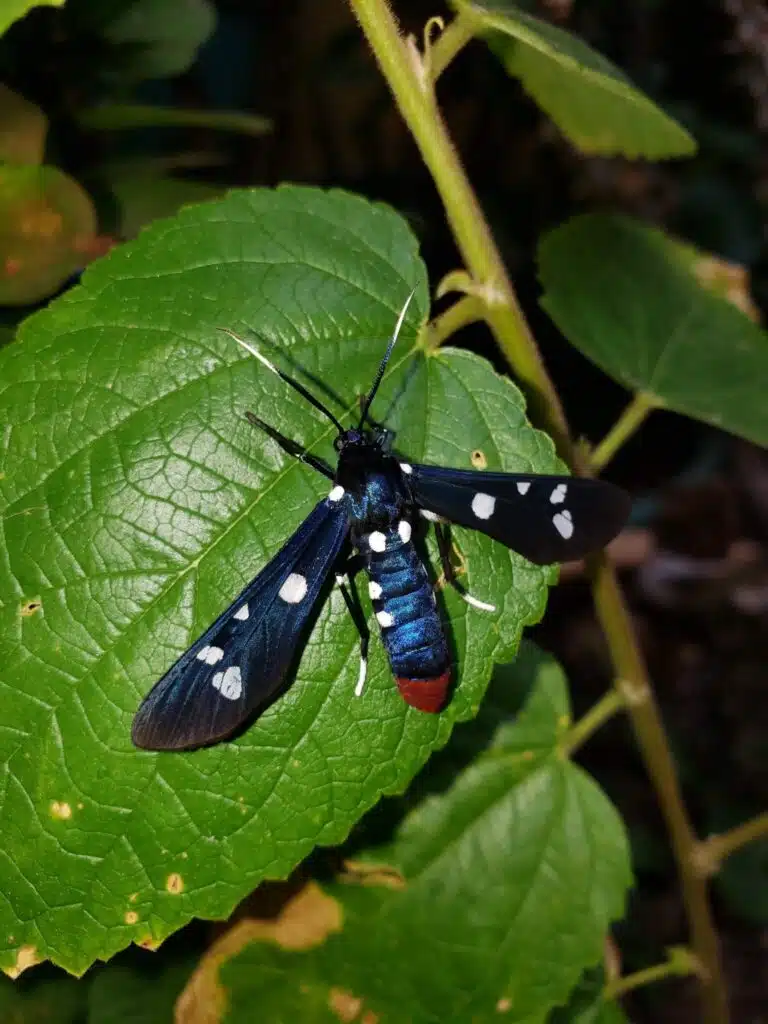
This species has a dark blue color which is seen across its body and its wings.
Moths of this species are the most common in Southern states.
While dark blue is dominant, the moth also has other secondary colors such as red on its lower body.
Red is believed to be a mimicry of either red or pink oleander flowers the moth feeds on.
Devil’s potato plants are another common host of the Polka-Dot Wasp Moth.
Its wings show white polka dots which make the species appear toxic.
2. Western Grapeleaf Skeletonizer Moth
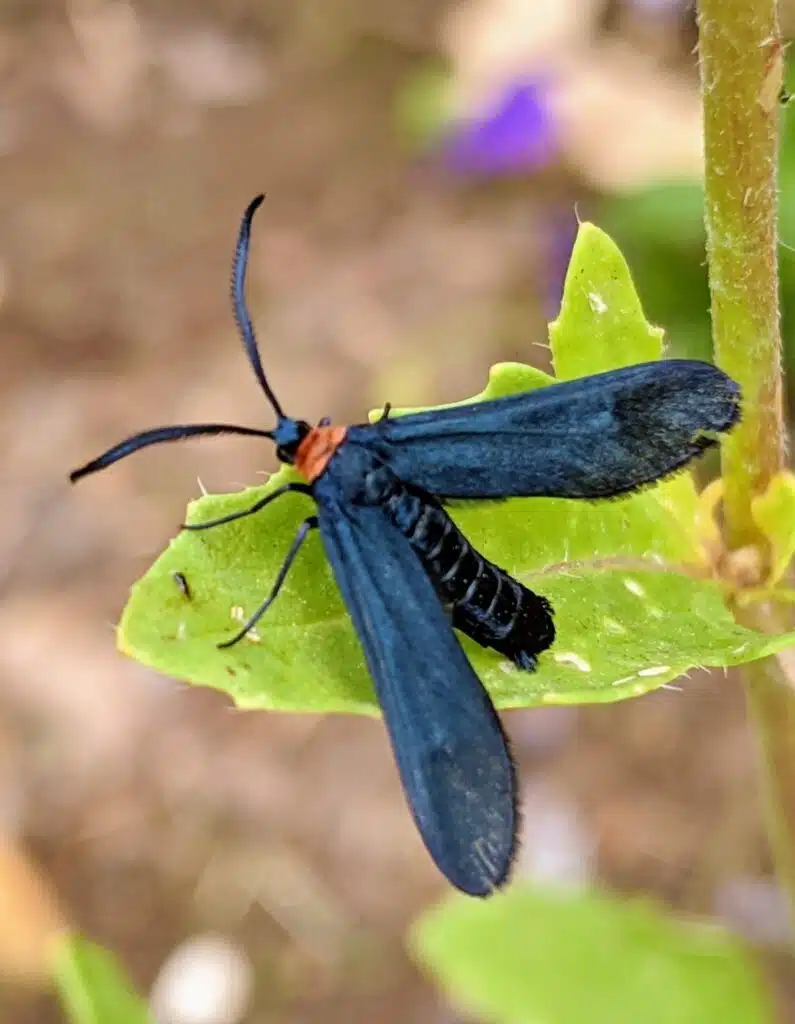
The Western Grapeleaf Skeletonizer Moth (Harrisina metallica) is a species that feeds on grapes.
It takes on the color of grapes for camouflage. This species has a mostly blue color.
Its body is dark blue, as are its wings. The legs and antennae of the species are also mostly dark blue.
This moth is found across California, Texas, Colorado, and Utah.
You might encounter it on grapevines in the garden but it lives in vineyards as a pest.
The moth has blue and yellow color as a caterpillar.
You should not touch the Western Grapeleaf Skeletonizer Moth caterpillars as they have urticating hairs.
Skin allergies are common when touching this species’ caterpillar.
3. Edwards’ Wasp Moth
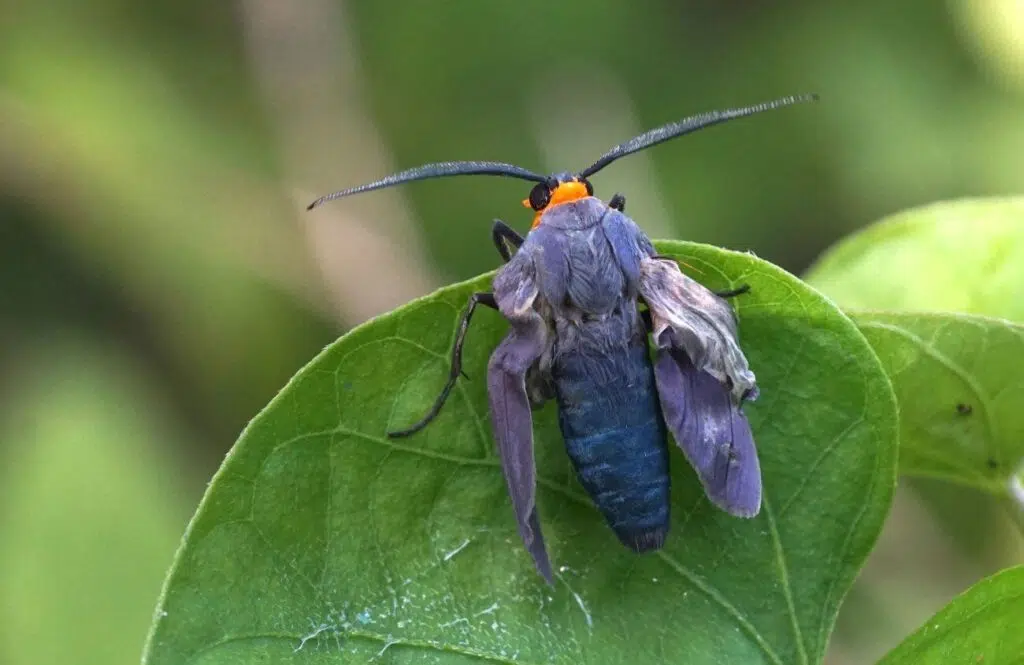
Edward’s Wasp Moths (Lymire edwardsii) are among the most common medium to large blue wasps in the country.
This species can reach a maximum wingspan of up to 40mm.
As Western Grapeleaf Skeletonizer Moth, this species also has a dark blue color.
Its forewings are dark blue to black as is its body. The species has a distinctive red spot on the back of its head.
Seeing an Edward’s Wasp Moth is not a good sign as this species is a known fig pest.
Figs on the street or around the house can be decimated by this species, particularly by its caterpillars.
You can spot its caterpillars on fig leaves by their yellow to green color.
These caterpillars eat leaf edges and not entire leaves, but they can still hinder fig health.
4. Faithful Beauty
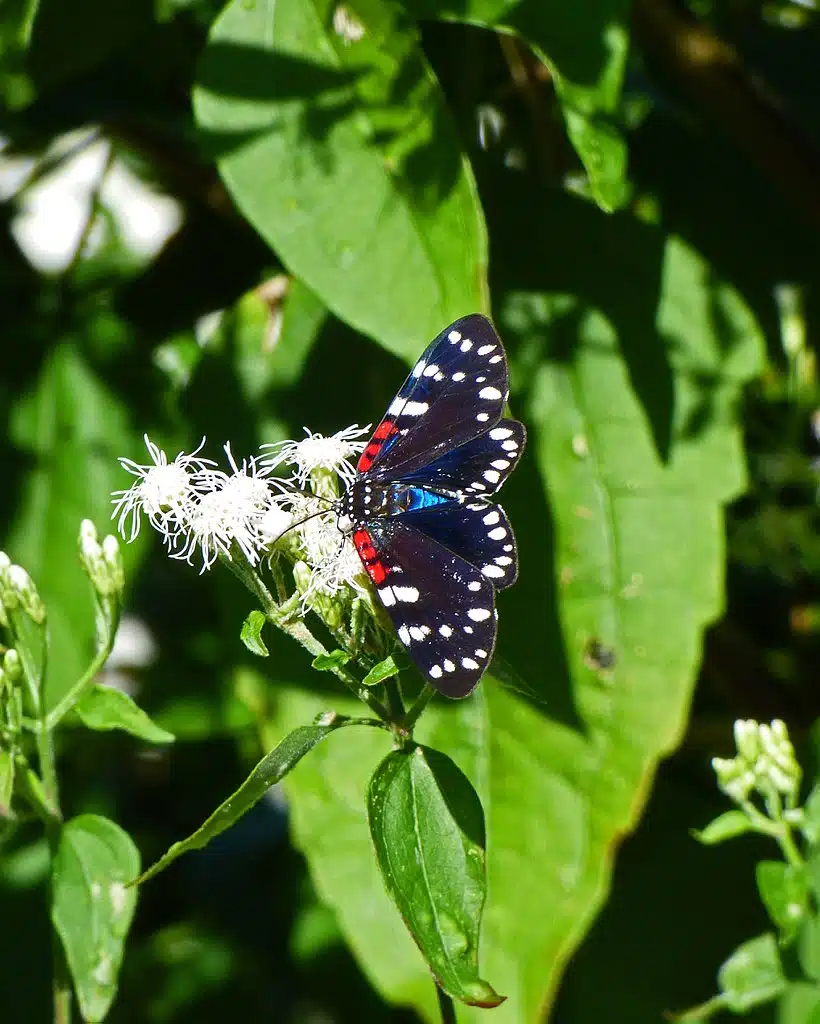
Faithful Beauty (Composia fidelissima) is a colorful moth that has multiple blue nuances across its body.
A base dark blue color is specific to this species across its dorsal body and its dorsal wings.
Light blue areas are seen on the upper sections of its forewings together with red markings.
White dots are further visible across the wings of the species.
This moth is among the largest blue species found in North America. It has a wingspan of up to 64mm.
Nerium plants and rose family plants are seen as the perfect host for this colorful species.
You can identify it on these plants by its colors as both its dorsal and ventral wings have a similar pattern of colors.
5. Bad-wing Moth
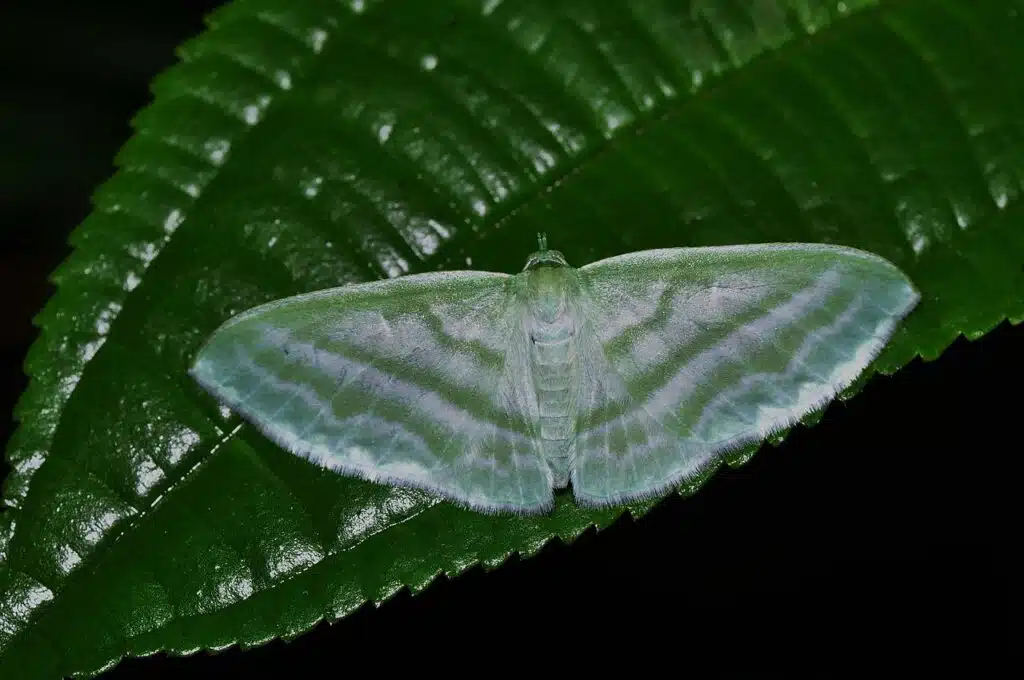
Bad-wing Moths (Dyspteris abortivaria) are a pale blue species native to North America with a limitation towards Eastern parts of the continent for habitat.
This species is one of the most common blue moths in the US.
A pale blue color is specific to the Bad-wing Moth.
This nuance is closer to marine blue and it’s met with a pale green ventral color.
Both its dorsal and its ventral sides are characterized by wave-shaped pale gray lines across the wings.
Bad-wing Moths are early fliers as they appear in April. Their season expands to August.
6. White-tipped Ctenucha
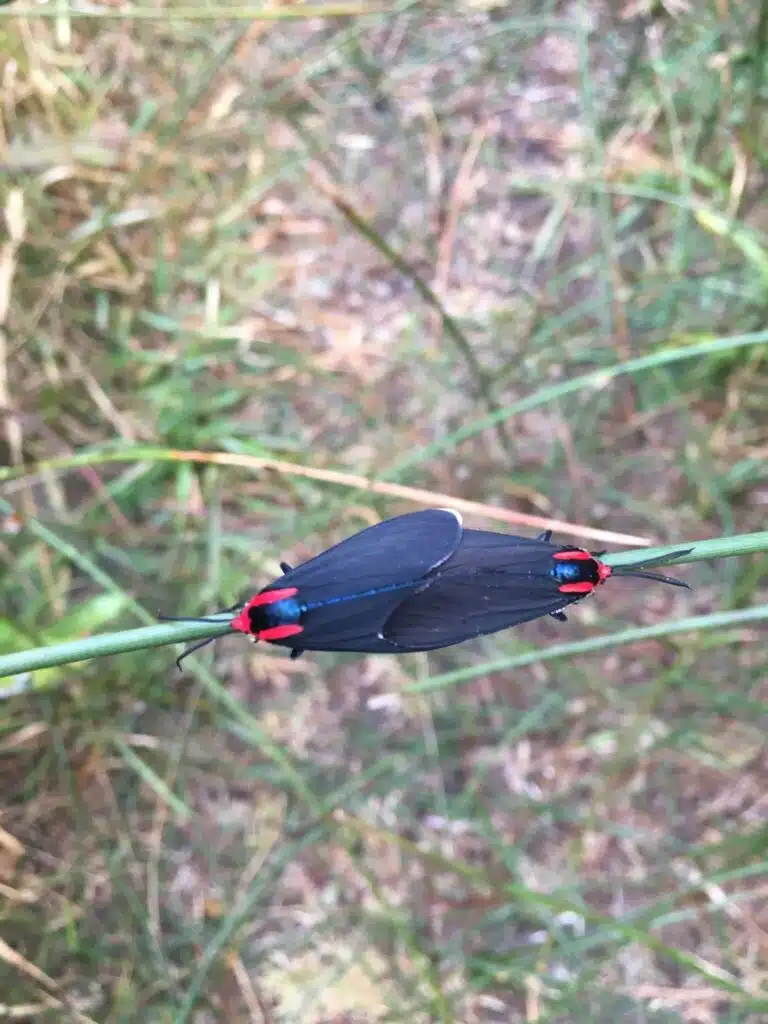
White-tipped Ctenucha Moths (Ctenucha rubroscapus) are a species native to Western North America. This moth only lives at low elevations across the continent.
White-tipped Ctenucha moths have black lower forewings and blue upper forewings with white borders that inspired their name.
These moths also have a red head with red body sections behind the head.
A maximum wingspan of up to 20mm is specific to this species.
These moths are mostly found on various types of grass they feed on such as cocksfoot grasses.
The caterpillars of the species also use short grasses as host species. You can identify the caterpillars of the White-tipped Ctenucha by their black color.
Both the caterpillars and the adult moths are only active until early September.
7. Virginia Ctenucha Moth
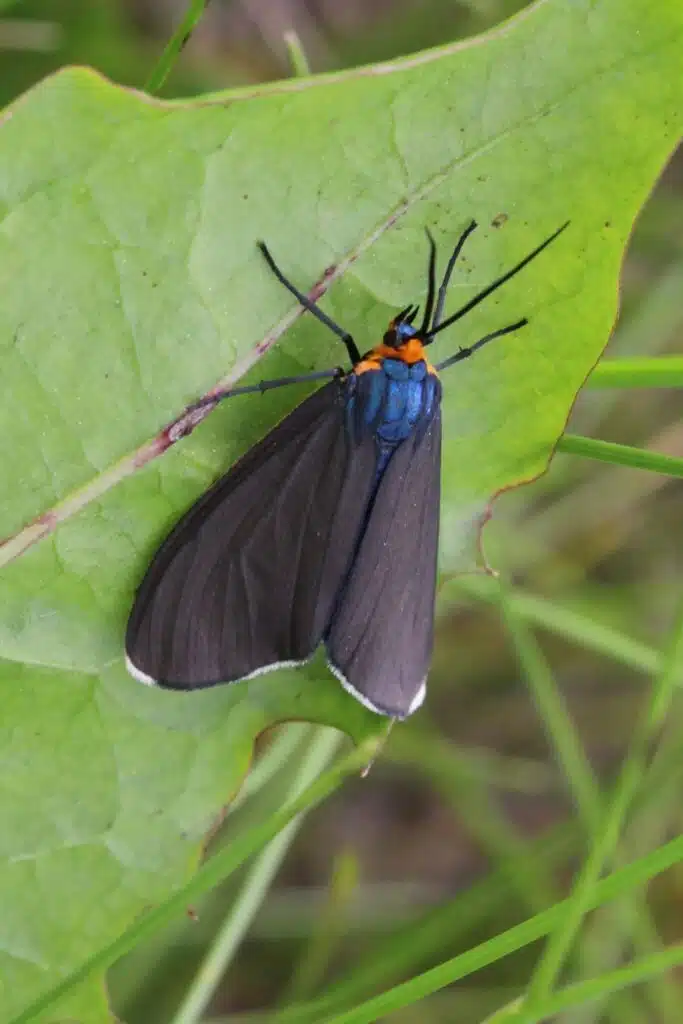
Virginia Ctenucha Moths (Ctenucha virginica) have a base black color with blue to green upper body sections.
This species has largely black wings, similar to other Ctenucha moths.
The forewings of the species are black, with narrow white margins. Only the upper parts of the wings closer to the head are blue.
This species has a yellow or orange head.
The size of the Virginia Ctenucha Moth can be considered as it can grow up to a wingspan of 50mm.
Moths of this genus feed on many types of plants. This includes grasses.
Sedges are also nectar-rich flowers this moth species feeds on.
As the name of the species implies, the moth can be seen in Northern states and Virginia.
8. Nine-spotted Moth
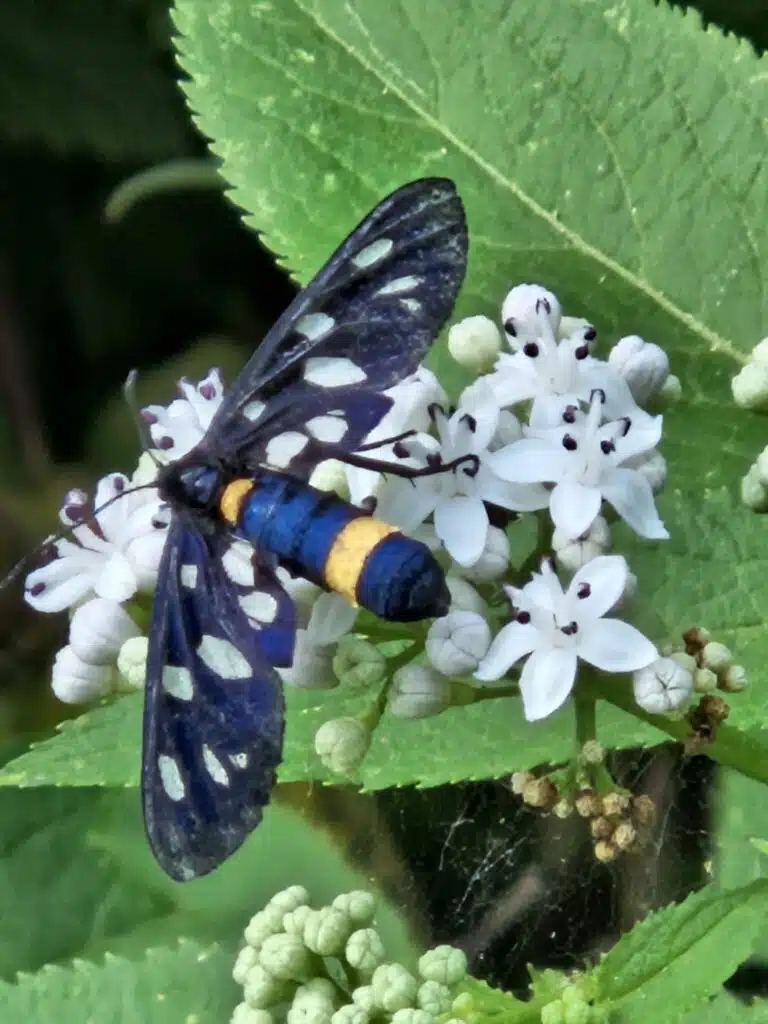
Nine-spotted Moths (Amata phegea) are most widespread in Europe.
This species has a known presence in woodlands across multiple dry areas and a coloring that makes it hard to spot.
Dark blue to black is the main color of the Nine-spotted Moth. This species is further known for the white spots across its wings which make it look poisonous.
A dark blue color is specific to its body. A yellow or orange band is further distinguished on its lower abdomen.
The moth also has a yellow or orange band just behind its head.
A common immigrant in many habitats, the species is mostly seen on herbs such as fleaworts.
9. Narrow-bordered Five-spot Burnet
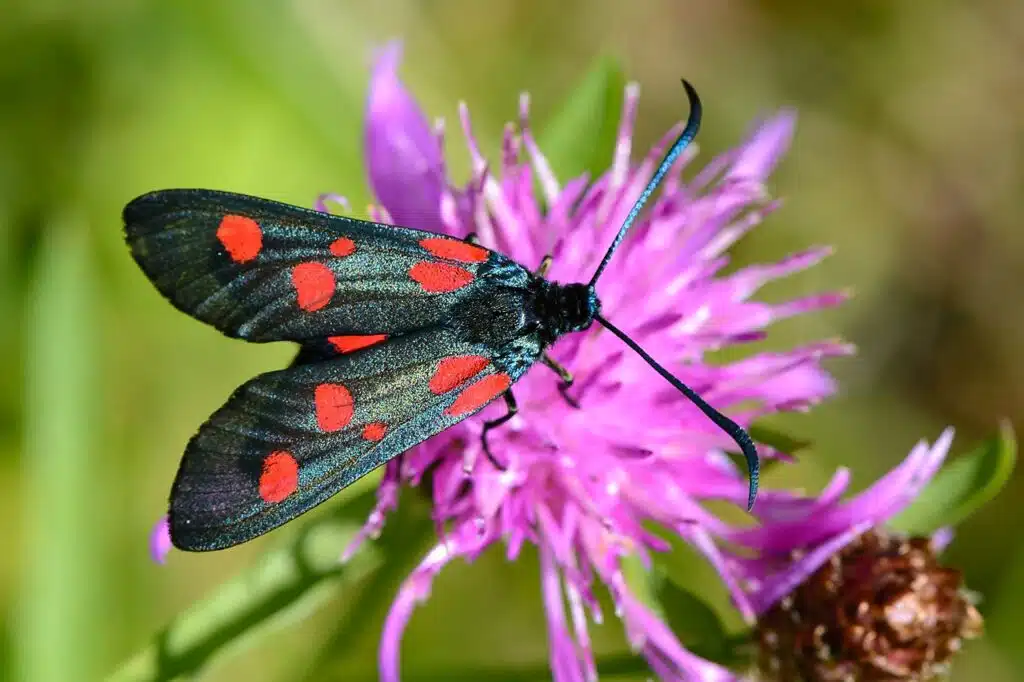
Narrow-bordered Five-spot Burnet moths (Zygaena lonicerae) have black and blue coloring. The species also has large red spots across its wings.
The upper section of its forewings has a light blue color. The black color is specific to the lower sections of the forewings.
Narrow-bordered Five-spot Burnet moths have a black head and a black upper body.
This species has black and orange ventral coloring.
Narrow-bordered Five-spot Burnet moths are found across dry habitats. They feed on various plants such as field knapweed.
Its caterpillars also grow on short vegetation and plants such as trefoil.
10. Zygaena transalpine
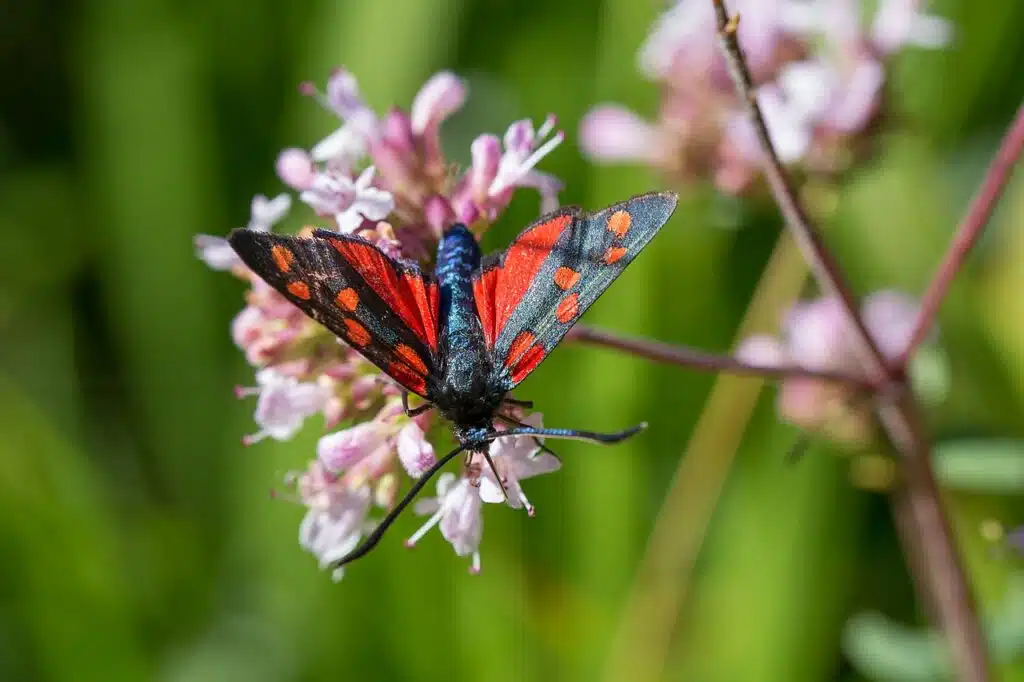
This species of native European moth has black and blue base coloring.
Its blue sections are visible across the forewings and the body of the species. Most blue areas are seen on the lower side of the hindwings while black dominates the upper side of the hindwings.
Red spots are further distinguished on the wings but not on the blue and black bodies.
This species of moths have a gradient body color which starts as black on the head and turns blue towards the lower body.
Other morphs of the moth include black and red or black and yellow colors.
11. Green Forester Moth
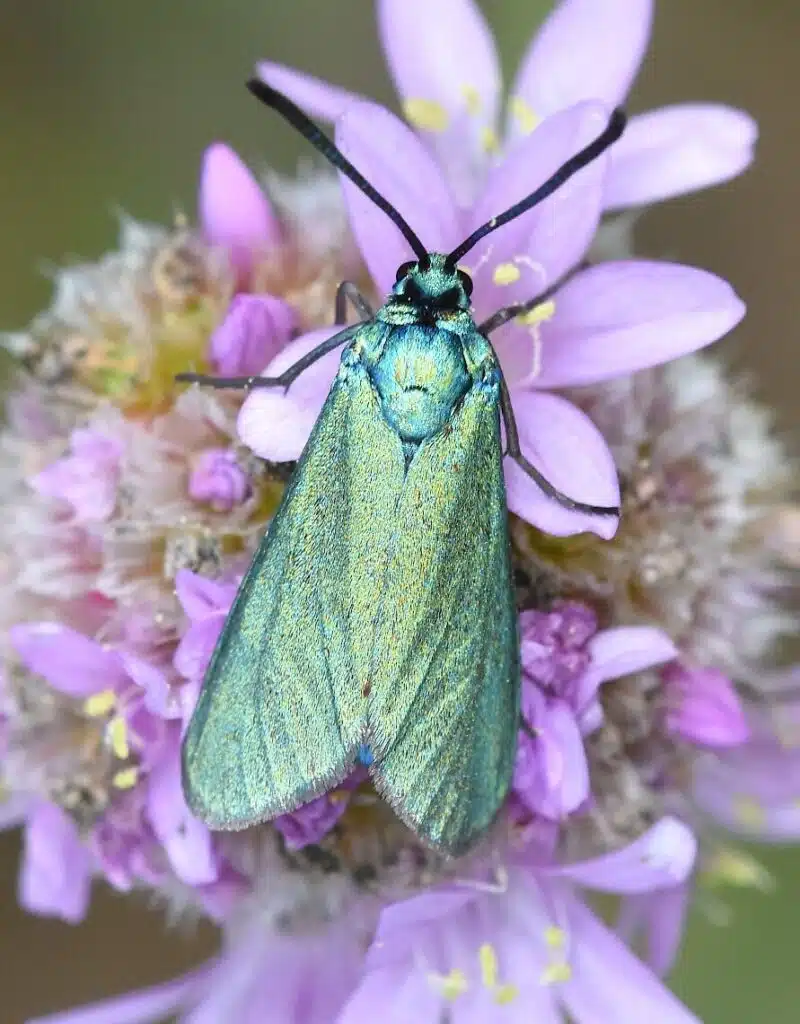
Green Forested Moths (Adscita statices) are known for their primarily metallic look. The species has a green body with a blue hue in direct sunlight.
Its metallic coloring is specific to all moths of this genus while the blue hue isn’t. Both the green moth and the green-blue moths have black legs and black antennae.
This species is mostly seen across Europe. The United Kingdom and Ireland are countries where this species is native.
It can be found in various fields and gardens since it feeds on decorate plants such as various sorrels.
Its caterpillars are also found on the same plant common in parks and gardens. The caterpillars can be identified by their mostly yellow coloring.
12. Scylla Firetip
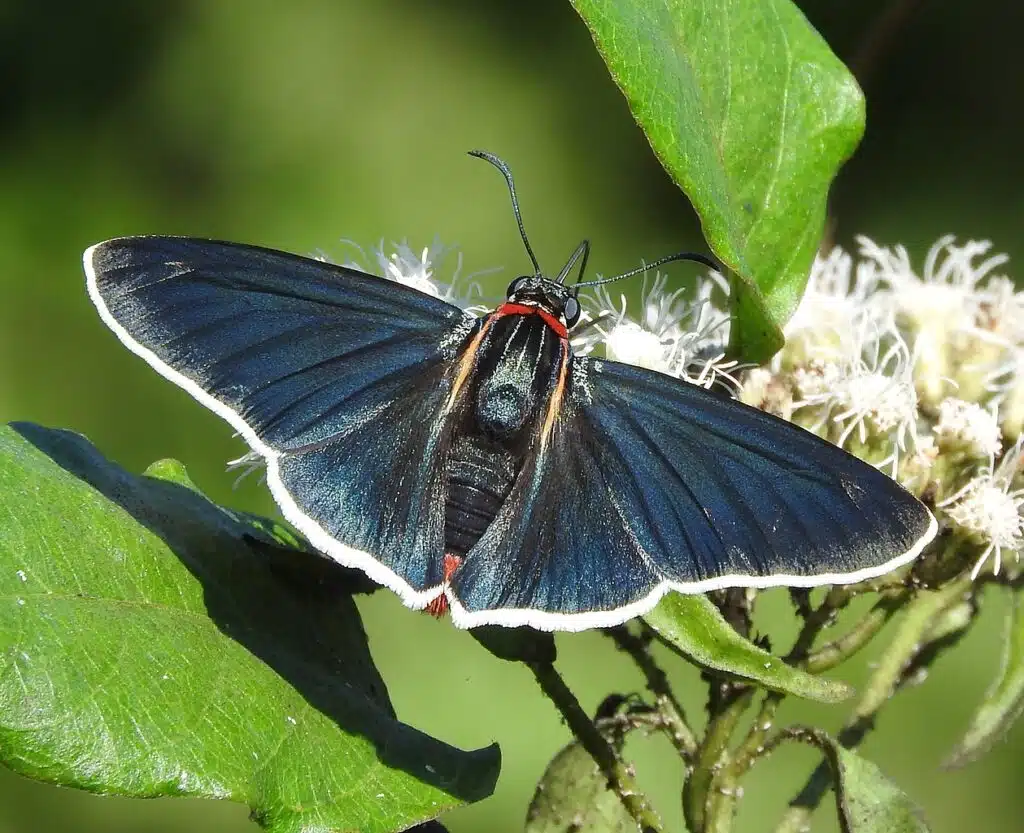
Scylla Firetip (Elbella scylla) is a species of medium to large blue moths.
This group is known for having different coloring between the sexes and in different morphs.
A common morph of the species combines green and blue. A rare sight in the moth’s world, this morph has left green wings and right blue wings.
A more common black morph with blue tints is specific to the species. This morph has white margins.
The head has a red color, as does the lower part of the hindwings close to the body.
13. Blue Day Moth
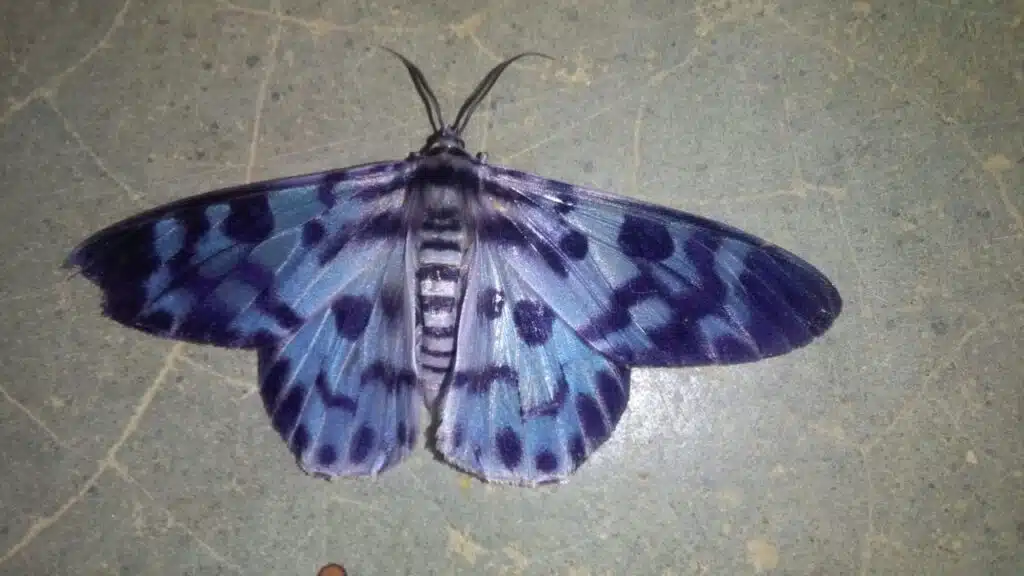
Blue Day Moth (Dysphania palmyra) is mostly present in Southeast Asia. This species has multiple blue nuances and it’s one of the most important moth pests of shrubs and trees in the region.
This moth is a pest of various shrubs green and black tea leaves are collected.
The species has a base light blue color. Dark blue spots are seen across its forewings together with dark blue lines and stripes.
Light and dark blue colors are specific to the pigmentation of its body. The head, antennae, and legs are also black.
Moths of this genus only have white margins on the lower hindwings.
Seeing one of these colorful moths is a bad sign since their caterpillars feed on various species of leaves from tea collected.
14. Pompelon marginata
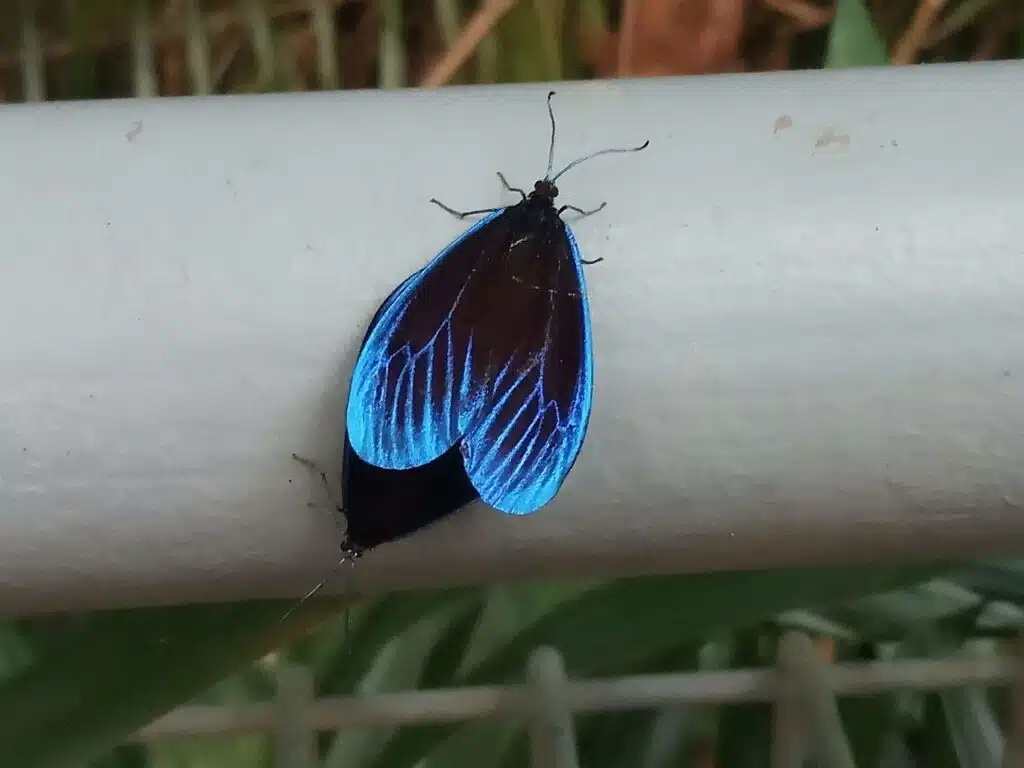
This species of moths are native to regions of Asia. It has a widespread distribution around laurel trees.
It only feeds on the leaves of these trees and it can be considered a major pest with serious invasions.
Its color is mostly black with blue segments.
The wings have a base black color with blue representing its veins and the lower part of the hindwings.
This moth species used this color to mimic other black and blue moths in the region that are poisonous.
Its caterpillars also use different techniques to defend themselves. This includes releasing a sticky liquid to keep other caterpillars away.
15. Blue Tiger Moth
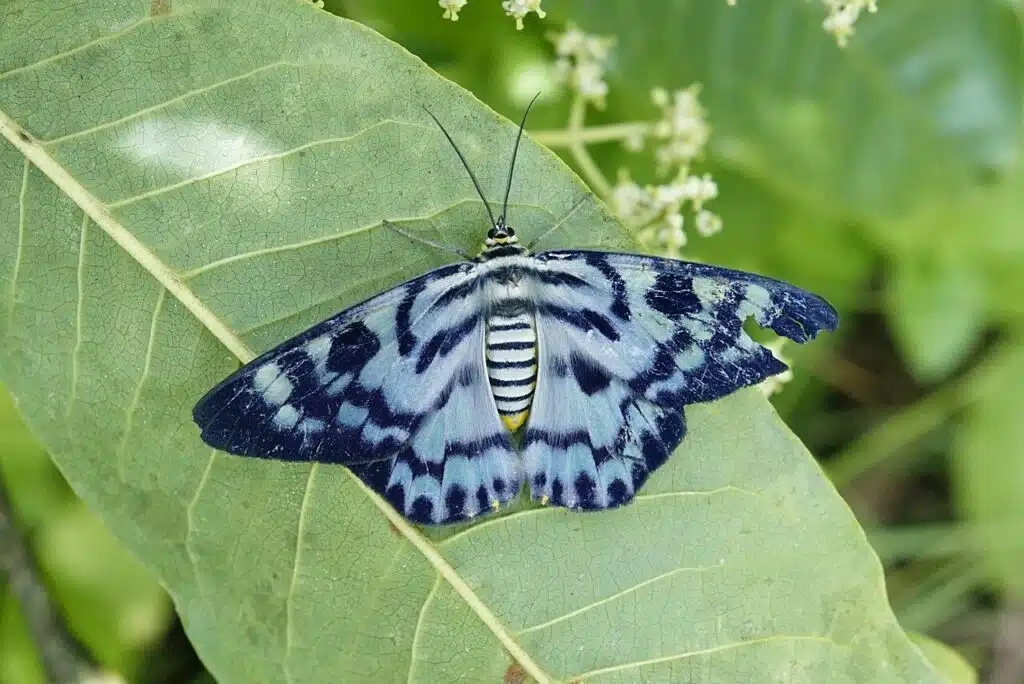
Blue Tiger Moths (Dysphania percota) are seen in black and white and a black, blue, and white color combination.
Females of the species show extensive blue coloring across the forewings.
White base coloring is specific to this species.
Black forewings with black sections across the hindwings are characteristic of the Blue Tiger Moth.
There’s some resemblance between the coloring of the caterpillar and the adult moth. The Blue Tiger Moth caterpillar has a blue-green and orange color with black spots.
16. Blue Underwing
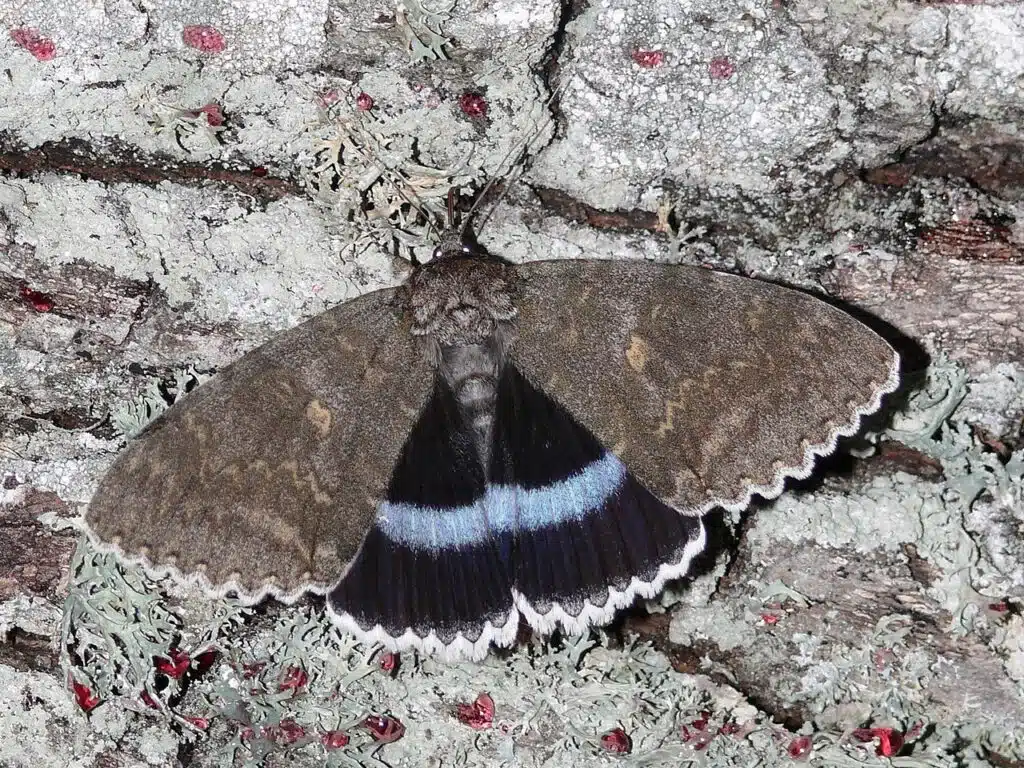
Blue Underwing Moths (Catocala fraxini) are native and widespread in Europe. This species is not among the most common species in North America.
Its name comes from the wide blue band across its hindwings. Moths of this genus have gray to brown forewings which they show when stationary on tree bark to improve camouflage.
Its hindwings are shown when flying. Black is the main color of the hindwings, together with the blue band and the white margins.
The larvae of the Blue Underwing also mimic tree bark. It has a base light gray color with dark grey sections.
17. Jasmine Moth
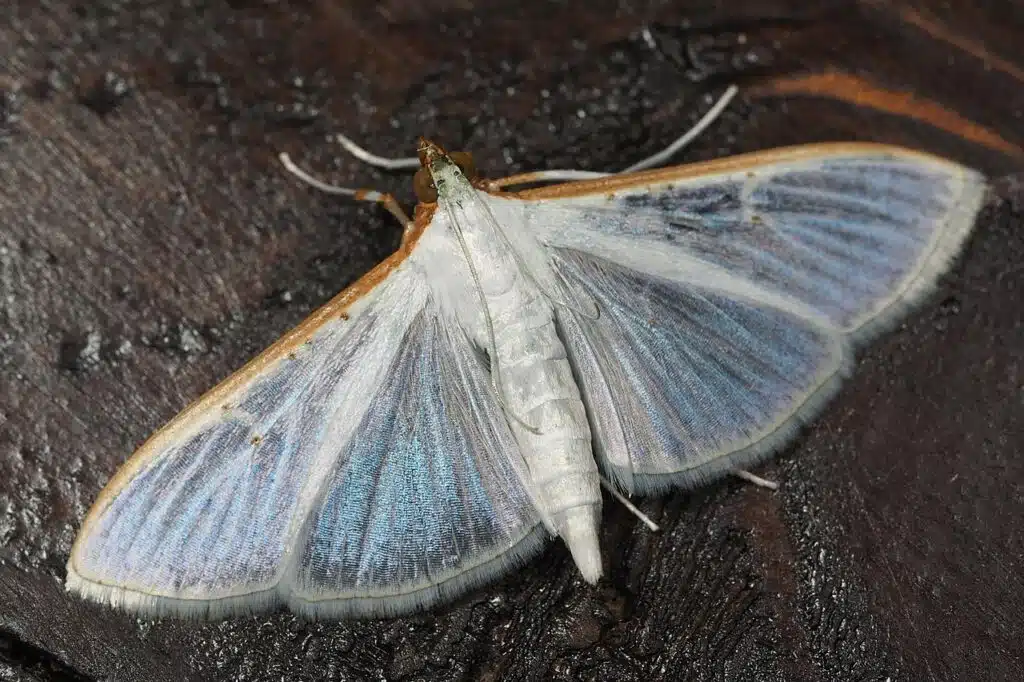
This moth species (Palpita vitrealis) is native to Africa, Europe, and Asia. It’s one of the multiple small species of moths that migrates.
Both short and long migration is specific to the Jasmine moth.
Arrowleaf sida flowers are its favorite host species in Africa. This moth also has different types of favorite plants across Europe apart from Jasmine flowers such as olives in the Mediterranean area.
In Europe, Jasmine Moth caterpillars are seen as major pests on olive crops.
Jasmine Moth caterpillars eat the stems, leaves, and fruits of olive hosts in Europe while they only rely on wildflower hosts in Africa.
Further Reading: